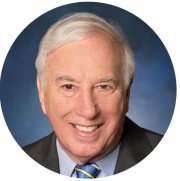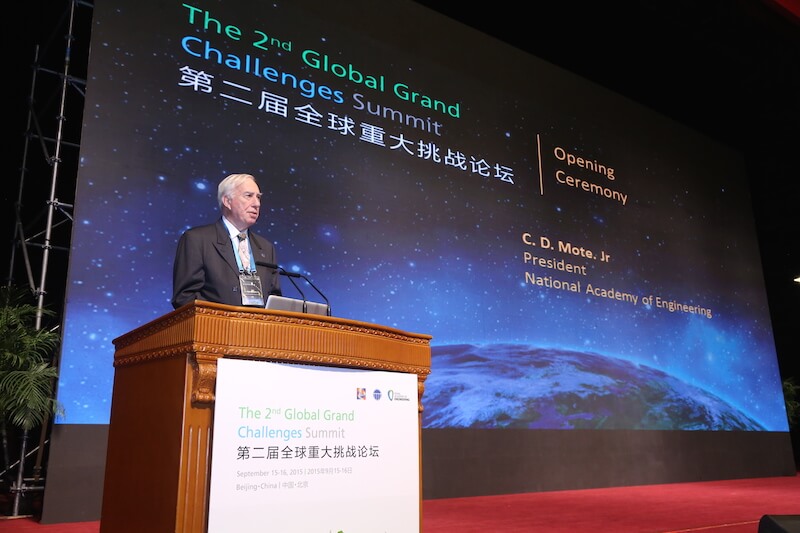In 2008, a distinguished NAE committee identified 14 ways that engineers could save the world as we know it, from securing cyberspace, to making solar economical, to engineering better medicines — essentially creating a call to arms for a new generation of engineers. C. D. “Dan” Mote Jr., president of the National Academy of Engineering, is leading the crusade, in collaboration with USC Viterbi. Editor Adam Smith talked to him about what the future holds for engineers and more.
Let’s talk about the 14 NAE Grand Challenges. You’ve played a significant role in promoting them globally. What’s been the response?
First of all, the Grand Challenges is not really a program like you would normally think of by industry or government. It’s much closer to a movement than it is to a program. The difference is, a movement is driven by an idea, an idea that draws people to it. So it’s not like you’re trying to accomplish an existing task as much as you’re trying to change the way people think.
We have the Grand Challenges and they have particular domains, but it’s really the idea of preserving life on this planet as we know it. That idea is what is attractive.
And in fact, the Grand Challenges themselves are 14 Grand Challenges, and if you read the report, you’ll notice right away that the committee never expected them to be the only challenges one could have. That was never the idea, but the idea of challenges that are important for the continuation of the planet is particularly captivating to people who have the same mind-set. These are people who like to solve problems, especially big problems. Engineers are particularly attracted to big problems: navigating the ocean, going to the moon and back, landing a robot on Mars and having it send information back. These are massive engineering projects that engineers just love.
It’s rare to find such unanimity on a global scale. Did anybody say, “These are America’s 14 Grand Challenges. We’ll adopt our own, thank you very much”?
Every time we go to a different country, whether it’s the U.K. or China or India, we should fully expect — and not be at all disturbed — if they decide we don’t really need these 14. We need 10, we need three maybe. We’re not going to get tied up on that issue. The point here is to bring people into the idea of grand challenges for the planet. And in fact, where we’re really trying to go, these problems will never really be solved unless we can get virtually everybody on the planet on board. Because ultimately, whatever solution you identify, people have to accept and want to implement it wherever they live and whatever their circumstances are. So ultimately, the game here is to create a movement that will bring everybody into the game.
The U.S. response, I should say, has been remarkable at this point. About a third of all engineering deans in the country now have signed up for the idea in a letter to President Obama. And if we get China and India on board, that’s about 40 percent of the world right there. So it’s obviously a big vision and big things can happen, but this is the right thing to do.
Of course, USC has been very prominent and right up front since the beginning, and it is very much in a leadership position, starting off with the Grand Challenge Scholars program [a hybrid curricular and extracurricular program that blends Grand Challenge research, global study, entrepreneurship, service learning and interdisciplinary work], from USC, Duke [University] and Olin College. That was the first breakthrough innovative effort on the Grand Challenges, and, as expected, it had a slowish start. But now it’s picking up speed. It’s branching out to the other parts of the world — in part because of a Global Grand Challenges Summits that we put together with the Royal Academy of Engineering and the Chinese Academy of Engineering, the first one in London in March of 2013, and the second one in Beijing in September of 2015. The third will be in the U.S. in 2017. Those essentially shine a global light on the Grand Challenges. In Egypt, the American University addresses the Grand Challenges, and there are other activities in the Middle East. People are looking at these challenges, looking at these ideas, and they realize it’s true that we have to get after them.
Some folks argue that we suffer an engineering shortage. Others will focus more on the quality issue — American engineers may or may not be prepared for the industry and government workforce. Where do you think the focus should be?
Everybody on the planet right now is looking for engineers. Every country, every company. Now, in the U.S., less than 5 percent of all undergraduate degrees go to engineering, according to NSF data. The NSF’s world average for countries is 13.5 percent. In East Asia, it’s 23 to 26 percent. Europe, 13 to 15 percent of all degrees go to engineering. We are under 5 percent, and half of that 5 percent doesn’t continue in engineering — they go to medical or business school or elsewhere. Engineering is a great education. They’re well educated and they do more things, but that reduces the number of people we have who are available for engineering jobs. So, at 5 percent we are very undersupplied with people with an engineering degree. For a country as dependent on technology and development for the future as the United States, to be down there with Cameroon in terms of percentage of degrees of engineering is just unconscionable.
One of the problems is people saying, well, we have this many engineering jobs and we have this many engineering grads, therefore there should be enough. That’s like saying we have this many people majoring in English and we have this many English jobs, therefore we should have enough. People do a lot of things other than what they study. A lot of people study engineering and actually don’t want to go into engineering. They have other ambitions, so you can’t just make that equation.
More than 25 percent of the NAE [members] has no degree in engineering at all. A third of the NAE officers have no degrees in engineering. These equivalences that people try to make between degrees and jobs in the field make no sense at all — there’s no way to justify them.
The other question about engineers sometimes being under-qualified for their position in the field — that’s definitely true. But of course that has always been true. When I graduated, it was expected that every graduate would have to be entirely retrained by the company that they worked for. This is nothing new, except now it’s worse. When I was a student, a student often worked for a company with a training program, and they might get moved from division to division as they got tuned up on what the company does over a year or so. And then they would make a career of that. That life doesn’t exist anymore.
Companies now hire people and they want them to do things right away. They don’t want a training phase, and so the graduate is never in sync with what their market is currently looking for. And that is always going to be true. I don’t see how that could be avoided, mainly because what the market is looking for changes very fast depending on what’s hot. …
When you talk to people in industry, you hear many ways they want more, not less capability. They want more teamwork, they want more multidisciplinary focus, they want more sensitivity to social sciences and dealing with people, as well as technical expertise and narrow focus, which is all understandable. I think the solution to this a bit of a conundrum, and I think it’s going to require the industry to take on more some responsibility for the education of their people the way they’d like to have them educated to serve their needs.
Tell me about a moment that contributed to you realizing, “Ah! This is what an engineer is! I can see myself doing this.”
Well, I think I was almost there, but I’d have to say my vision was very small scale to start with. I didn’t have a Grand Challenge kind of vision about what we needed to do for the planet, which I regret now.
Back when I was an assistant professor in mechanical engineering, I had a graduate student say to me, “I’m an A+ student in mechanical engineering, just passed my Ph.D. qualifying examination, and I want you to supervise my dissertation research on snow skiing.” And originally I said no because you’re not suppose to work on things that are fun. You won’t get a job, I won’t get promoted, this isn’t going to work out very well.
So he left and two weeks later he came back frustrated, saying, “I’ve been all over this department and everybody says the same thing.” And then he said to me, “Well, why are you a professor, anyway?” Perhaps a little more nicely than that.
I gave him the usual answer: You want to know how things work, and then you want to find better, faster, cheaper, thinner, superior solutions to their problems. And he said, OK, but you have to agree that snow skiing satisfies all those conditions. No one knows why a ski turns. Surrender!
So we started working on why a ski turns. And we started getting mail right away, and it was piling in. But no one cared about why a ski turns. Everybody cared about why they got hurt. At that time, the snow skiing injury rate was 7 injuries per 1,000 skiers per day. That’s a really high injury rate. So we started to shift and work on injury problems. Why do people get hurt? How can injury rates be reduced? And that turned out to be a global problem because basically all the equipment manufacturers have their own global markets and global standards. So that essentially meant taking on the world’s snow skiing problems through committees of global participants from all across the snow skiing world. Creating a professional society, standard organizations on the global level. And ultimately that reduced the injury rate from 7 to about 2.2 or 2.3 injuries per 1,000 skiers per day. So that huge global engineering systems problem was a transformational experience for me.





